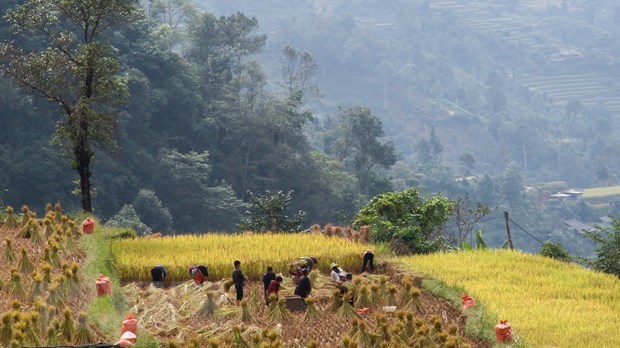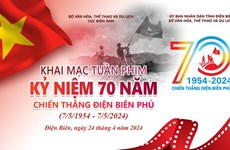Vietnam’s Co Lao ethnic group preserves cultural traits
 Red Co Lao live in villages on the side of the Tay Con Linh Mountain range in the northern province of Ha Giang. (Photo: VietnamPlus)
Red Co Lao live in villages on the side of the Tay Con Linh Mountain range in the northern province of Ha Giang. (Photo: VietnamPlus)
Ha Giang (VNA) – The cultural traits of the Co Lao ethnic minority people in Hoang Su Phi district are a deeply held and charming feature of the northern mountainous province of Ha Giang.
Located in the western part of Ha Giang province, Hoang Su Phi is well-known for its stunning landscapes and its 13 ethnic groups, including the Co Lao.
The district is also one of the localities with harsh weather and environment. Fortunately, harsh living conditions and geographical factors have not hindered locals from retaining many unique aspects of their longstanding traditional culture.
With maize and rice as their major crops that dominate the Co Lao honour agriculture, and each year the group organises a post-harvest festival, which is central to their beliefs.
Families prepare boiled chicken and pork, sticky rice, white wine, fruit, gold coins and incense as offerings for the ceremony.
A shaman is invited to carry out basic rituals to thank the gods, heaven, earth and ancestors for bountiful crops.
Then Ngoc Minh, chairman of the Hoang Su Phi People's Committee, said the post-harvest festival reflects the typical agricultural beliefs of the Co Lao.
"Every year, after harvesting rice and corn, the Co Lao people hold the ceremony to express gratitude to the gods and ancestors for blessing them with good weather and bountiful crops," he said.
They also pray for a new bumper harvest for the next crop with favourable weather conditions, happiness, and prosperity.
 Village chief Min Pha Khay (left) talks about a ritual ceremony. The Red Co Lao people hold rituals to thank the gods, heaven, earth and ancestors for bountiful crops. (Photo: VietnamPlus)
Village chief Min Pha Khay (left) talks about a ritual ceremony. The Red Co Lao people hold rituals to thank the gods, heaven, earth and ancestors for bountiful crops. (Photo: VietnamPlus)Apart from the rituals, the ceremony also features festivities such as folk singing and games.
The Co Lao, one of Vietnam’s 54 ethnic groups, has a population of more than 4,000. The group settled in the country about 200 years ago and live mainly in the northern mountainous region. They have other branches such as the Green Co Lao, Red Co Lao, and White Co Lao in Hoang Su Phi and Dong Van districts in Ha Giang.
Growing rice on terraced fields and maize, buckwheat, green peas, and roots is the main farming work of the Co Lao.
Nguyen Huu Son, vice chairman of the Vietnam Folklore Association, said: "Life for the Co Lao has improved a lot. In the past, they wove fabric and used natural dyes. Now they buy cloth to make their clothes, but their costumes maintain the original decoration and design."
A Co Lao village has 15 to 20 households of the same clan. They make earthen-wall houses with alang grass roofs. The Co Lao worship ancestors going back three or four generations.
Earlier this year, the post-harvest festival of the Red Co Lao ethnic group and the Ban Vuong worship ceremony of the Red Dao in Tung San and Ho Thau communes were included in the list of national intangible cultural heritage of Vietnam. This helps the cultural and spiritual life of ethnic minorities in the northernmost mountain province of Ha Giang's Hoang Su Phi district rise to new heights.
The Ban Vuong worship ceremony is how the Red Dao in Ho Thau Commune express their gratitude toward Ban Vuong, the legendary ancestor of the 12 Dao clans. Besides, it shows the ethnics’ aspiration for a peaceful life, good weather and bumper crops.
The worship of Ban Vuong is related to the destiny of each person, each clan, and the entire ethnic group.
Taking place between the 15th day of the 10th lunar month and the 30th day of the last lunar month, the event is also a ceremony to pray for communal prosperity.
Previously, the worship ceremony usually took place over three days and three nights. Today, it is shortened but still retains its sacredness./.












